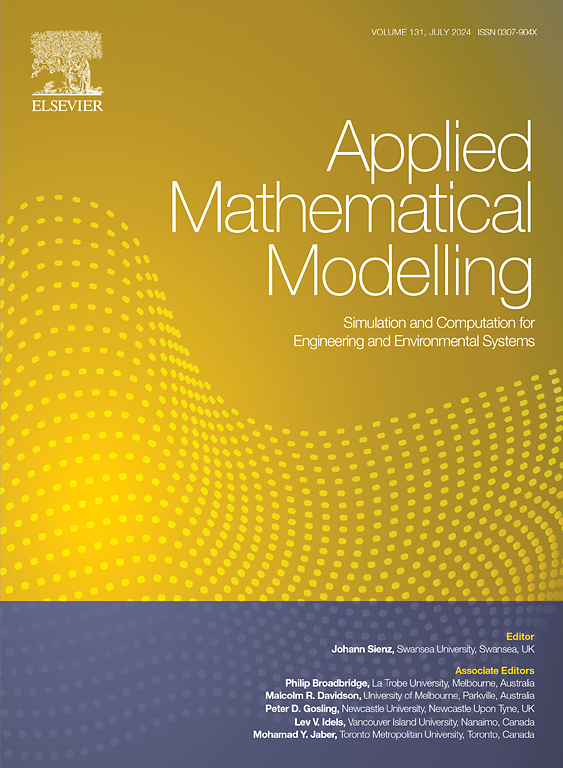Flexible-rigid dynamics and vibration suppression of slender structures on partial space elevator
IF 4.4
2区 工程技术
Q1 ENGINEERING, MULTIDISCIPLINARY
引用次数: 0
Abstract
This paper studied the coupled flexible-rigid dynamics of a partial space elevator with slender and flexible structural appendages on the main satellite with the goal of suppressing flexural vibration of the appendages caused by climber movement. The partial space elevator is modeled as a two-piece dumbbell system, with the local dynamics of the main satellite simplified to attitude and flexural motions of appendages using modal decomposition. Flexible-rigid dynamic coupling occurs at the main satellite, where its attitude and flexural deflection of appendages interact with the orbital motion of the partial space elevator induced by the climber's movement. However, the main satellite’s influence on overall libration and orbital dynamics is negligible due to the large tether-to-satellite size ratio, allowing local decoupling of its dynamics. Accordingly, the dynamic model for the main satellite is locally decoupled from the libration and orbital dynamics of the partial space elevator to analyze the dynamic characteristics. This model reveals two distinct features: (i) steady state of flexural deformation of appendages (under which, appendages will be in a bending deformation state without vibration) occurs from gravity gradient difference across the partial space elevator, an effect absent in standalone satellites with similar slender and flexible structural appendages; and (ii) a steady state for the partial space elevator does not guarantee a steady state for the flexible appendages, even with zero initial deflection. By treating the flexible-rigid coupling effect and modeling approximation errors as disturbances, a sliding mode control law based on modal decomposition of a beam is developed to suppress flexural vibration of appendages during climber transfer by exclusively adjusting the tether length at the end body. The stability of the control law is proved by Lyapunov theory. Numerical simulations demonstrate that the proposed control law effectively suppresses the flexural motion of flexible structures on the main satellite throughout the climber transfer.
部分空间电梯细长结构的柔刚体动力学及振动抑制
以抑制爬升器运动引起的部分空间电梯附件弯曲振动为研究对象,对主卫星上带有细长柔性结构附件的部分空间电梯进行了柔刚体耦合动力学研究。将部分空间升降机建模为两片式哑铃系统,利用模态分解将主卫星的局部动力学简化为附件的姿态运动和弯曲运动。主卫星发生刚柔动力学耦合,其姿态和附件的弯曲挠度与爬升器运动引起的部分空间升降机的轨道运动相互作用。然而,主卫星对整体振动和轨道动力学的影响可以忽略不计,因为系绳与卫星的尺寸比很大,允许其动力学局部解耦。据此,将主卫星的动力学模型与部分空间升降器的振动动力学和轨道动力学进行局部解耦,分析其动力学特性。该模型揭示了两个明显的特征:(1)部分空间升降机上的重力梯度差导致附属物的弯曲变形稳态(在此状态下,附属物将处于无振动的弯曲变形状态),这在具有类似细长柔性结构附属物的独立卫星中是不存在的;(ii)即使初始挠度为零,局部空间升降机的稳定状态也不能保证柔性附件的稳定状态。将刚柔耦合效应和建模近似误差作为扰动,建立了一种基于梁模态分解的滑模控制律,通过单独调节端体系绳长度来抑制攀登者转移过程中附件的弯曲振动。利用李亚普诺夫理论证明了控制律的稳定性。仿真结果表明,该控制律有效地抑制了主卫星柔性结构在爬升器转移过程中的弯曲运动。
本文章由计算机程序翻译,如有差异,请以英文原文为准。
求助全文
约1分钟内获得全文
求助全文
来源期刊

Applied Mathematical Modelling
数学-工程:综合
CiteScore
9.80
自引率
8.00%
发文量
508
审稿时长
43 days
期刊介绍:
Applied Mathematical Modelling focuses on research related to the mathematical modelling of engineering and environmental processes, manufacturing, and industrial systems. A significant emerging area of research activity involves multiphysics processes, and contributions in this area are particularly encouraged.
This influential publication covers a wide spectrum of subjects including heat transfer, fluid mechanics, CFD, and transport phenomena; solid mechanics and mechanics of metals; electromagnets and MHD; reliability modelling and system optimization; finite volume, finite element, and boundary element procedures; modelling of inventory, industrial, manufacturing and logistics systems for viable decision making; civil engineering systems and structures; mineral and energy resources; relevant software engineering issues associated with CAD and CAE; and materials and metallurgical engineering.
Applied Mathematical Modelling is primarily interested in papers developing increased insights into real-world problems through novel mathematical modelling, novel applications or a combination of these. Papers employing existing numerical techniques must demonstrate sufficient novelty in the solution of practical problems. Papers on fuzzy logic in decision-making or purely financial mathematics are normally not considered. Research on fractional differential equations, bifurcation, and numerical methods needs to include practical examples. Population dynamics must solve realistic scenarios. Papers in the area of logistics and business modelling should demonstrate meaningful managerial insight. Submissions with no real-world application will not be considered.
 求助内容:
求助内容: 应助结果提醒方式:
应助结果提醒方式:


